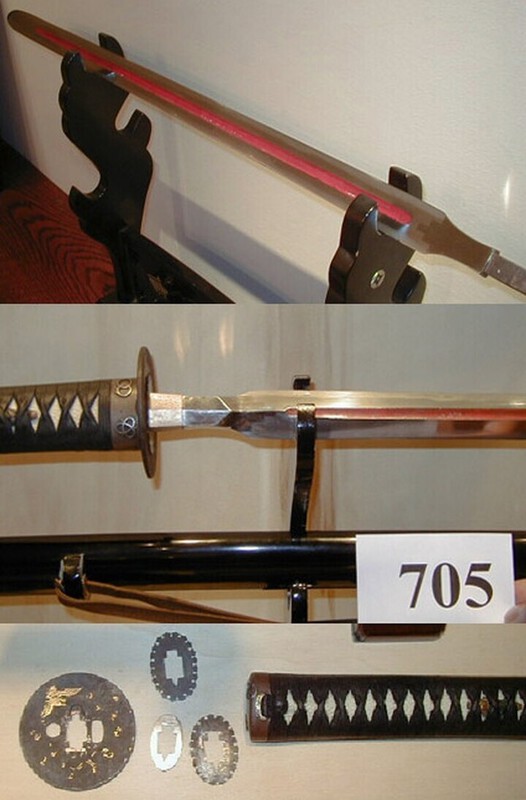-
Posts
117 -
Joined
-
Last visited
Everything posted by DKR
-
Time passes... friends must go... but memories remain. Bruce... a unique guy. Both in his appearance and his demeanor. In both pockets of his jeans, he almost always had tsuba, which he worked on with horn or bone at almost every opportunity... sometimes even in the morning at diner breakfast. I will never forget the expression on the faces of the other guests when they saw Bruce at work in the morning at breakfast. In 2002, I first heard one of his almost legendary lectures on sukashi tsuba at the table of a dealer friend in Tampa. I have never met anyone with such a keen eye for good iron tsuba. It was in San Francisco... in 2003 or 2004, on the last day, just before closing... Bruce and I, a group of four, were strolling through the sword show. At one table, swords lay in five or six layers, completely jumbled together. Bruce stopped, reached into the stack, and pulled out a rather poor-looking wakizashi in a koshirae. On the koshirae was a Kanayama tsuba. I couldn't believe my eyes. I must have walked past it 6 or 7 times before...looked through the stack...and I didn't see it...and Bruce strolls past and däng, he sees it immediately. Crazy in a positive way...that was Bruce for me. Rest in peace my crazy friend
-

Kicking the hornets nest question ;)
DKR replied to obiwanknabbe's topic in General Nihonto Related Discussion
I made this mekugi nuki from a dead blade. It worried some people a lot when they see it the first time. In the past I see a mekugi nuki with a signature from Kotetsu. The owner explain that it was from a cracked blade . -
Get in contact with Paul Kremers .https://tsuba.info/ He can answer all your questions seriously and he know from what he is talking about.
-
@ Rafal https://www.touken.or.jp/english/ Contact the museum. If there are any guidelines or legal requirements for preserving Japanese weapons, they'll be able to tell you. But I'm afraid you personally, as an amateur, won't get an answer to this question. Perhaps if your contact at the museum in Krakow tried it, the chances would be better. Sincerely, Your Tripod
-
I have made a mistake. It is completely clear and correct that a katana against a naginata naturally has the shaft as the target of attack. Everything else doesn't work either because of the lack of range. I don't know why but had only naginata versus naginata in mind. Excuse me , my bad.
-
@ROKUJURO...........and why should an attacker attack the shaft of the Naginata instead of the wearer or the hands themselves? Have you ever seen a practice fight in Naginata Jutsu (better Naginata Do) ? The targets of attack are the legs, hands, arms, head etc., the body of the opponent. But not the shaft of the Naginata. What makes you think that the Tsuba you show above is a Naginata-Tsuba? How many Naginata with Tsuba have you seen? Can you show us pictures of Naginata with Tsuba, i.e. real objects, not paintings or scrolls, please. Most of the ones I've seen didn't have a Tsuba. But they did have a strong thick Seppa... nothing more.
-
I'm sorry, but there is no Yari Tsuba. That's nonsense. What could be, however, is that it is a modified Tsuba which has been mounted on one of these oddities Koshirae. Example in the picture including your " Tsuba for a Yari" These fantasy mounts are mostly relatively new .....perhaps tourist souvenirs
-
Dear Jaqcues, now I'm very disappointed in you. It is very clear to see that this tsuba was originally a normal tsuba. So for a katana or waki. So this is not a tsuba for a yari! At best an example of a converted tsuba.........and nothing else.......... and then even worse......you, especially you, call you tube a serious Source for information ?
-
Nice , very nice ! That shows very good features of Koshirae in the " Tensho Style" .
-
If someone want to see Tensho Koshirae , take a look in the Katalog from the great exhibition "Uchigatana koshirae" from the Tokyo National Museum. In this Koshirae from Aoi Art i can't see features that are typical for so called " Tensho Koshirae " The piece looks to me as if it was put together from different parts that never really belonged together. The style as well as the overall appearance does not match Koshirae which had become fashionable in the late Muromachi / Momoyama period. But that's just my opinion
-
@Brano A beautiful, impressive work...even if it's just pictures. Thank you for showing it. It's been two years now since I had the opportunity to buy a Shinsakuto blade. It's a work by "Yasumune" in the Yamashiro style. I personally believe that he "tried" to make a blade in the style of Kuniyuki. With modern blades, you always have to have a certain tolerance when it comes to copies of old swords...but there is a certain similarity. Especially when you look at the Ochigata in CSM101's post.
-
@Gary that reminds me of the Samurai Art Museum ( Peter Janssen Collection) in Berlin. It started also with the problem that there is not enough space..........and it end in a very remarkable private Museum in Berlin. So, be very careful Happy Christmas to everyone.
-
This is one of the typical blades that is better viewed live in your hand. Pictures are not enough here.
-
Really?........you are sure ?
-
Ok a sabi Tsuba ......indeed.
-
Sorry, but this Tsuba is in the first line in a very bad condition. Active red rust all over the plate. I can't see "wabi" aesthetic in this piece.
-
What type of sori ? Saki sori, Koshi sori, Tori sori......?
-
And now you explain why some famous Hizen smith , like Tadayoshi or Masahiro ( Mainline) always make a Tachi mei on a blades what definitively are Katana. sorry, but I can't resist.
-
I can only repeat and emphasize what Thomas has already written. An impressive blade with a very good polish. Absolutely excellent. And you were not out of place. This feeling is absolutely normal and not a mistake. I assure you that there were some who knew even less about Kiyomaro or quality criteria than you. When it comes to this, you can't learn something like that from books or even from the Internet. You only learn and understand something like that in practice with the blade in your hand. Of course it is very helpful if there is someone there who can explain something to you. And that is exactly what events like this are good for! You did everything right. You didn't fall into any traps. That alone is an achievement that most people wouldn't be able to achieve straight away. So from me again: Thank you very much for your willingness to make the blade accessible to an interested group of people.
-
Back to the topic of Kuruma.......I like this motif too. In the picture you can see my two Tsuba on the topic. Left side Hozon paper "Ono" dimensions 73mm x 72mm, rim is 7mm thick. Right side, no papers yet, dimensions 78.5mm x 77.5mm, rim is 8mm thick I have read opinions about the right Tsuba and heard that it might be a Kanayama Tsuba. But there is too little of the Tekkotsu typical of Kanayama to be seen here. The material looks a bit "sandy" but also has structure. I see something like that more in Ono and not in Kanayama. I personally believe that it could be an Ono Tsuba. If I put the two Tsuba directly next to each other, they are very similar in many ways......but who am I to determine which Tsuba comes from which school. I don't care, to be honest......for me they are both good Tsuba that I enjoy a lot.
-
Be careful! First Question to you : What kind of sword do you have ? A Chinese "wannabeejapanesesword" ? ......no problem , go on . Ask them for references for their work. So pictures that were taken before and after the work was done. Or do you own a antique Japanese sword , signed and papered by the NBTHK, a value pice of Japanese history ? In this case you should get in contact with a serious Agent who let the work done in Japan by experience craftmen how know there job. That's my two cent.











